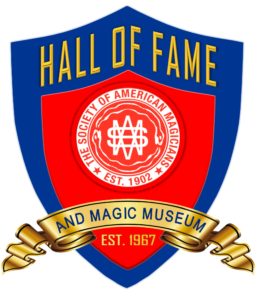The S.A.M. Hall of Fame and Magic Museum
1963
A dream and vision of long standing, the concept of a Hall of Fame was proposed in 1963 during the term of Edward Schneider as National President. He officially called for a magic hall of fame where collections, records and documents could be maintained and exhibited. He had strong support from Past National President Milbourne Christopher and S.A.M. member Benjamin Kleinman, who kept the idea constantly before the National Council.
1966 – 1971
In 1966 John Zweers was elected National President, and by 1967 he had added the Hall of Fame as a permanent standing committee to the
S.A.M. Constitution. The Hall of Fame was established and a search began for its permanent home.
In 1970 an ideal location was found in Hollywood, California. Through the generous donation of space in a newly constructed bank building the Hall of Fame began to take form. On the first day of National Magic Week, October 25, 1971, the Hall of Fame and Magic Museum was officially opened by National President J. Gary Bontjes.
1971 – 2004
In 1979 the Hall and Museum was incorporated under the laws of the State of California as an independent entity, authorized by S.A.M. It is a non-profit, tax-exempt educational institution dedicated to preserving magic’s history. The Hall and Museum was constructed and was staffed entirely by volunteer labor. It was and is financed entirely through donations from individuals and grants from the S.A.M. National Council and Magic Endowment Fund.
The Hall of Fame features photographs and hand-drawn portraits of the magicians elected into the Hall of Fame by the National Council upon the recommendations of the National Historians Committee. Magicians elected to the Hall date from Dedi of Ancient Egypt to contemporary stars of magic. These portraits looked down upon the J. Gary Bontjes Memorial Stage in the John U. Zweers Memorial Theater, where visitors to the Hall and Museum were entertained by local magicians on regularly scheduled program nights.
The Magic Museum had approximately 7000 square feet and encompassed the history of magic from 3000 B.C. to the present. Exhibits included equipment and apparatus of magicians such as Thurston, Blackstone, Kellar and Dante. Posters from the Golden Age of Magic to Le Grand David and David Copperfield graced the walls. Many exhibits were tableaus with lifelike figures of magicians performing their signature effects.
December 2004
A transformer explosion in a City of Los Angeles Department of Water and Power vault across the street from the Hall of Fame facility sent odorous smoke into the Washington Mutual Bank Building that housed the Hall of Fame Museum as well as the Pacific Pioneer Broadcasters’ Museum. The bank closed its building for remediation. The bank restored and reopened its facility but the two museums remained sealed and inaccessible for years.
Throughout this ordeal, the Society of American Magicians remained committed to preserving the priceless artifacts, posters, costumes, memorabilia and documents that trace the history of the magical arts. However, it became apparent that the physical structure within the bank would no longer be able to house the Hall of Fame Museum.
August 2010
Access to the Hall of Fame Museum artifacts became available in 2010. In August, all magic artifacts were carefully cleaned, packaged and moved to storage. Non-magic items such as mannequins, seating and furniture were sold or disposed of. Search for a new home for the Society of American Magicians Hall of Fame is currently underway so that this magnificent collection can once again be made available to magicians and the public alike. A significant portion of the Hall of Fame collection is currently on display at the Whittier Historical Society and Museum in Whittier, California.
How Can You Help?
Donations in any amount are appreciated, and will be held in a separate account specifically for the preservation and reconstruction necessary to restore this important repository of magic’s history.


I made a page on MagicPedia for the SAM Hall of Fame: http://www.geniimagazine.com/magicpedia/SAM_Hall_of_Fame
We have links to short biographical sketches of just about everyone in the Hall of Fame, in case you are interested.
– Joe